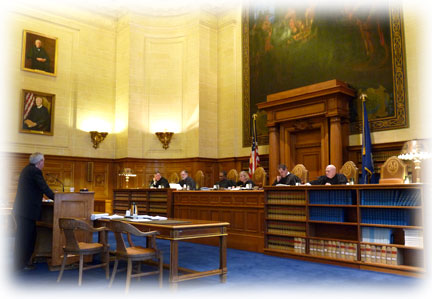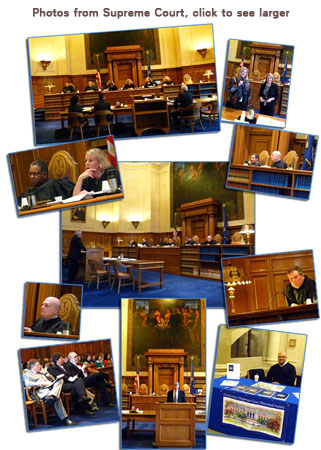|
A Celebration of the
100th Anniversary of the Supreme Court
and State Library Building
(Part 3 - Supreme Court Courtroom)
By
Judge Henry S. Cohn
 The third
argued case took place in the current Supreme Court courtroom,
in the building that was the subject
of the celebration. At 2:45 p.m., State Librarian Kendall F. Wiggin gave a brief
talk on the building and its opening on December 1, 1910. He mentioned Chief Justice Simeon Baldwin’s interest in moving
the Supreme Court from its location at the State Capitol to a
new building across the street. The State Library, also at
the Capitol, was in need of storage space for books, records and
historic archives. With the new building functioning, the
State Library on September 21, 1926, received from Governor
Henry Cabot Lodge of Massachusetts, an important archive of the
Trumbull papers, originally given by the family to Massachusetts
for safe-keeping. The new building also was constructed
with a Memorial Hall, where the founding documents of
Connecticut are displayed, as well as portraits of the state’s
governors. In conjunction with the Memorial Hall is a
state history museum that displays Charter Oak artifacts, Colt
guns, and an extensive coin collection.
View display poster The third
argued case took place in the current Supreme Court courtroom,
in the building that was the subject
of the celebration. At 2:45 p.m., State Librarian Kendall F. Wiggin gave a brief
talk on the building and its opening on December 1, 1910. He mentioned Chief Justice Simeon Baldwin’s interest in moving
the Supreme Court from its location at the State Capitol to a
new building across the street. The State Library, also at
the Capitol, was in need of storage space for books, records and
historic archives. With the new building functioning, the
State Library on September 21, 1926, received from Governor
Henry Cabot Lodge of Massachusetts, an important archive of the
Trumbull papers, originally given by the family to Massachusetts
for safe-keeping. The new building also was constructed
with a Memorial Hall, where the founding documents of
Connecticut are displayed, as well as portraits of the state’s
governors. In conjunction with the Memorial Hall is a
state history museum that displays Charter Oak artifacts, Colt
guns, and an extensive coin collection.
View display poster
The notable
cases argued in the Supreme Court courtroom include numerous
attacks on Connecticut’s anti-contraception statute. Although the statute was upheld in the Connecticut Supreme Court
(see, e.g., State v. Nelson, 126 Conn. 412 (1940), appeals were
taken to the U.S. Supreme Court, concluding with Griswold v.
Connecticut, 381 U.S. 479 (1965) (statute unconstitutional). From
Griswold’s rationale, the Supreme Court arrived at its
decision in Roe v. Wade, 410 U.S. 113 (1973) (abortion legal). Other appeals of note were
Horton v. Meskill, 172 Conn. 615
(1977) (property tax and equal education in all towns); Sheff v.
O’Neill, 238 Conn. 1 (1996) (abolishing de facto segregation);
Kelo v. New London, 268 Conn. 1 (2004), affirmed, 545 U.S. 469
(2005) (whether condemnation had legitimate public purpose); and
Kerrigan v. Commissioner of Public Health, 289 Conn. 135 (2008)
(gay couples have a state constitutional right to marry).
At 3 p.m., the
argument in
Pham v. Starkowski, SC 18582, on appeal from the
Hartford Superior Court, Docket No. CV 09 5034410 (2009). The attorney for the appellant, Department of Social Services
Commissioner Starkowski, was Hugh Barber, and the attorney for
the appellee, Pham was Nicholas Yorio of the Legal Aid Society
of Hartford. The Chief Justice remarked that the ceremony
was an important one and complimented the staff on making
arrangements. View
CT-N Video
The issue in
the appeal was the legality of P.A. 09-05, a public act that had
eliminated a social service medical program for aliens residing
in Connecticut for less than five years. In 1996 Congress
passed a five-year residency rule for legal aliens to qualify
for Medicaid, while leaving the states free to change or
eliminate the five-year period. Connecticut had acted so
that its social services health program did not contain the
five-year exclusion; but citing the budget crisis, the General
Assembly had in P.A. 09-05 returned to the federal five-year
exclusion. The Superior Court had ruled in favor of the aliens,
finding that the 2009 public act violated the federal Equal
Protection Clause.
The appellant
in the Supreme Court, the Department of Social Services, argued
that the Superior Court was incorrect in holding that P.A. 09-05
was to be judged under a strict scrutiny standard, not a
rational basis standard. If the rational basis test were
used, instead of strict scrutiny, interference with a legal
alien’s right to medical care could be justified by state
budgetary considerations. The Department of Social
Services also argued that aliens had no equal protection rights
to the social service program in 1996, so that eliminating the
program would not amount to discrimination.
The attorneys
stayed after oral arguments to discuss the case with the
audience, many of whom were University of Hartford paralegal
students. One question involved how the attorneys used
paralegals to prepare for the oral arguments. The answer
was that the paralegal assembled exhibits, prepared appendices,
proof-read briefs, engaged in electronic filing of documents,
and helped with basic legal research. The attorneys also
pointed out that this appeal was rapidly prepared for hearing,
as the attorneys agreed to an expedited briefing schedule.
The Supreme Court heard the case only one year after the
Superior Court Judge filed his opinion. The attorneys and
the audience also discussed the recusal of Justice Katz from the
day’s proceedings as she was named the next commissioner of the
Department of Children and Families.
Reception (Part 4) >>
Home
Attorneys
| Case Look-up | Courts |
Directories |
Educational Resources | E-Services |
Español | FAQs |
Juror
Information | Media |
Opinions | Opportunities |
Self-Help |
Home
Common Legal Words | Contact Us |
Site Map | Website Policies and
Disclaimers
Copyright © 2016,
State of Connecticut Judicial Branch
|



